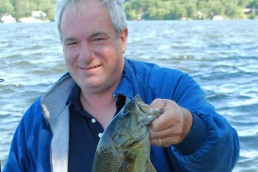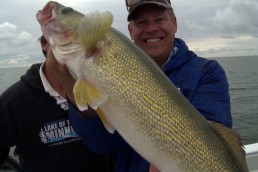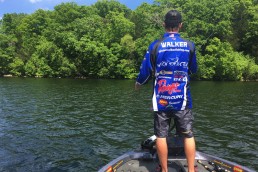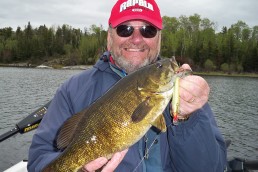Smallies Bottom-up in the Summertime
SHARE THIS POST
It’s a pattern that works all summer, but Fred Matero and I took a few outings to put this together despite how simple and obvious it may seem. And we didn’t expect our presentations to rise from fishing 35-foot depths to hook smallmouths on surface plugs over submerged rocks once the evening faded.
If you fish a lake or reservoir with clear water, surface action may happen regularly at the beginning of an outing. But during the afternoon, it’s best to drop lead heads to the bottom.
Successful days can begin deep, slow, subtle, and then gather momentum as the spirit of advance increases, finally to break out in clear view like an explosion of a bass out of the water. And perhaps not just one; a number of them in quick succession as if to celebrate yet another successful upturn. It’s like the polar opposite of the quiet efforts foreshadowing the melee, and makes an outing a full experience rather than when arriving late, and only for the surface play.
The variety of jigs—football, round head and others—all lend themselves to use, as do differences in weight. But the main thing to keep in mind is to use as little weight as needed and whatever form of lead head suits your style. I typically use cone-shaped leads, because I like headlong probing along the bottom. And, unless wind makes feel and control impossible, I’ll try to get a 1/8-ounce jig as deep as 30 or 35 feet—that takes patience.
Most of the tournament specialists I know throw as much as 1/2 ounce to probe that deep, and they don’t necessarily cast with a 5 1/2-foot, medium-power St. Croix spinning rod as much as I do. Personal preference means choice, as do trends among your buddies. But there’s a real difference down there between a 1/8-ounce jig tipped with a 3-inch Berkeley Gulp Leech or Keitech plastic with a large wide-gap hook and a 1/2-ounce lead with a big skirt and chunk of plastic in the middle. A difference exists between how the lighter jig is retrieved compared to a larger one.
Are you enjoying this post?
You can be among the first to get the latest info on where to go, what to use and how to use it!
I like to let a jig spend a lot of time “nosing” along among those rocks. Summer bass, even in colder depths, possess alertness more than ones in cold-water months, so I’ve adopted the notion that I don’t have to do much to attract them; I do the opposite. I’ll try to be unassuming, and it works.
When the sun angle is low, when clouds move in, or even better, when a front is coming through with thunderstorms miles away, shallower rocks can become productive in 12 to 20 feet. Growing up in the 1970s, Mann’s Little George lures interested me and I never forgot these curious lead weights with the tail-spinners—each weighing 1 ounce—with the body shaped almost exactly like a tiny barred sunfish an inch long. These lures work great. Clip them along the tops of rocks with a fairly quick retrieve. And if you mark on the recorder any sort of drop, the lure “parachutes” downward when you let it fall, spinner flashing, resulting in jolting strikes. I have read little about this lure since it first hit the market, but it deserves mention.
Typically, the “fireworks” usually start as the sun is about to set. No, we don’t throw our Torpedos, Pop-Rs and Dalton Specials out over rocks 10 or 12 feet down. One of the lakes we fish is so clear that the local mindset includes the notion of never finding bass any shallower than 10 feet. But I’ve spent time on foot observing what goes on along the shorelines. One of the interesting sights involved finding dozens of shiners swimming inches from the dry edge in water barely covering their backs. Once I witnessed a small bass rush in and grab one in its maw, and then propel itself back into the depths.
On this lake we especially target the edges of weeds or reeds, but even a typical bank line will often do. I fire the plug right at the very edge, let it sit a long time and give it a good pull. This imitates a bass making a kill, and usually seems to get other bass interested.
Topwater fishing is a variable affair; what works one night, won’t another. Even the time in relation to sundown when bass become active varies, but almost every evening offers some excitement. So vary those retrieves and find the tempo. Always try to make the action of the plug as lifelike as possible.
MWO
SHARE THIS POST
Did you enjoy this post?
You can be among the first to get the latest info on where to go, what to use and how to use it!
Bruce Edward Litton
MidWest Outdoors works with more than 200 outdoor experts each year, who contribute articles based on their areas of expertise. MidWest Outdoors magazine offers more fishing and hunting articles than any other publication!



